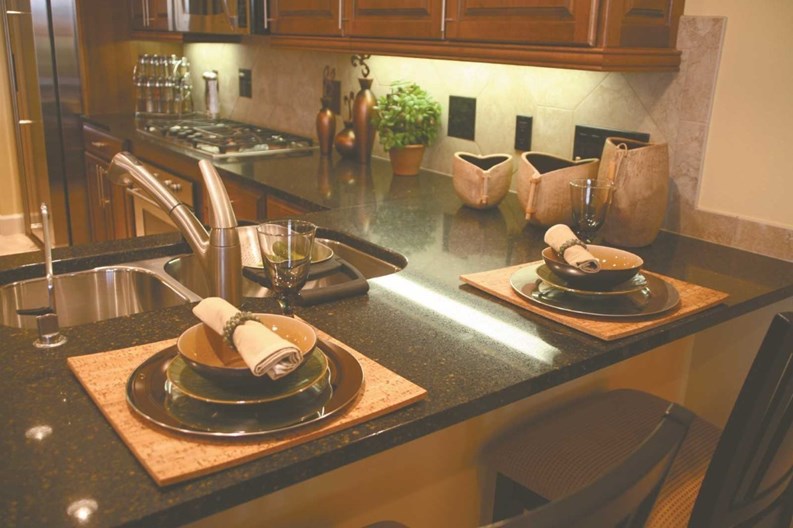A recent British survey found that the typical person spends an average of five years of their life in either their kitchen or their bathroom. That might not compare with the number of hours logged behind a desk or the wheel of a car, but it’s a significant chunk of time. With both time and space at a perpetual premium in New York City, homeowners seeking to maximize their enjoyment and comfort in these defining rooms really have their work cut out for them.
“Whether you are venturing into a new design or considering a renovation of your kitchen or bathroom, understand that this is not just any space that you want to make aesthetically pleasing, but [a space that] needs to be truly functional—as well meeting your budget guidelines,” says Catherine Daly, principal of Medford, New Jersey-based design firm Design East Inc.
“These two spaces have the greatest impact on future potential buyers and the value potential of the overall home price,” she says. According to Daly, “The overall return on your investment in these two rooms will be 90 to 100 percent.” In her line of work, clients frequently ask the same questions in terms of price, time, where to begin, in addition to considering what trends will really add “wow” factor to a room.
Lessons Learned
Embarking on a remodel is a significant undertaking, explains Steve Babus, a designer at New York Kitchen & Bath in Manhattan. “A lot of people coming from out of state do not realize that costs are 25 to 30 percent higher in New York, and there are other hidden costs, like permits.” He explains that said administrative costs alone can range from $250 to $1,000. Additionally, certain new buildings require isolated water shut-offs, water proofing and soundproofing, which can cost between $5,000 and $15,000 depending on various factors.
“Realtors will often not tell buyers about these fees and requirements. The information can be found by checking with the building management company and looking at the renovation application,” says Babus. Over the last 25 years, he says he has seen changes in the remodeling of co-ops and condominiums, especially with kitchens. “Everyone wants an open-floor plan, which for most co-ops with a small kitchen means the removal of walls or creating knee-walls with stool seating.”
As long as the walls involved are not load-bearing, how they’re reconfigured is limited only by space and the client’s imagination. Designers can draw computer-aided designs (CAD) of board-accepted plans, allowing them to tweak different aspects of the design and offer clients multiple views and options. The majority of firms also have engineers and architects on staff to handle projects that require significant restructuring of walls, drainage or piping. On average, involving these professionals can add upwards of $1,500 or more to project costs.
Ethelind Coblin, principal of Manhattan-based firm Ethelind Coblin Architect, PC stresses the understanding of the necessary working variables to create a winning design solution. “Bathrooms and kitchens involve almost all of the trades, so there are all kinds of coordination issues taking place in a very constricted space,” says Coblin. These spaces are packed to the limit with storage given the restricted footprint conditions in New York City, she says. “The number of decisions that have to be made in these rooms is exponential.”
Among critical variables are budgets and schedules. A bathroom or kitchen remodel will take on average between three and eight weeks, providing materials are ordered in advance. “For a bathroom remodel, you have to understand that you will be without a working toilet for at least three weeks,” says Babus. “Most of our clients make arrangements to stay elsewhere, especially if it’s a one-bathroom unit.”
All designers provide contracts with loose verbiage such as “substantial completion.” A caveat is necessary because often snafus happen that are beyond the control of the designer such as waiting on materials.
“Be cognizant that whether you are in the planning stages of a new home or a remodel, all projects have imperfections or challenges that can take more time, so understanding all your options now versus later is invaluable,” says Daly.
Materials at a Glance
With the “green” movement gaining considerable momentum, more consumers are looking to reduce their carbon footprint by investigating in environmentally materials. “We are seeing more Caesarstone, for example,” says Babus. “It is green-friendly, non-porous and low-maintenance.”
Coblin adds, “We love green materials such as bamboo. We just completed a kitchen and bath with it… We love the new porcelain materials…[which] look just like slate and limestone and are almost indestructible. We have been happy with glass and glass tile backsplashes. Once the soap stone breaks in, it is beautiful. There’s no end to quality materials.”
While it might seem that an uptick in certain products results in back-orders, Babus says, “most vendors keep up with trends. For glass backsplashes, for example, we have a one week turn-around time.”
When approaching lighting, Daly encourages the evaluation of lighting locations with a concentration on the home’s relation to the sun. “Another strategy is adding ‘environmental’ low voltage lighting in the bathroom under cabinet at the base and in the kitchen adding low voltage above and below cabinets.”
With regards to appliances, the trend remains strong with stainless steel, and black as a second surface color choice. Popular cabinetry woods are cherry, maple, and painted creamy finishes versus white in the kitchen and bath, explains Daly. For countertops granite remains in vogue. “Standard edges can keep cost down, as well as researching granite colors that are less costly,” she notes.
For customers’ seeking high-end materials and appliances in the kitchen, Coblin points to brands like Wolf, Viking, Miele, Cluny, and Aga. For the bathroom, custom stone bathing vessels are gaining popularity as well as fixtures from Sherle Wagner, Kalista, Duravit, Waterworks, KWC, Samuel Heath, and Hansgrohe, she says.
Due Diligence
Daly says her clients want their bathroom or kitchen done “right” the first time around, which is accomplished by a symbiotic relationship based on research, diligent planning and sound communication. “It is important to take your lifestyle and home price into consideration when making design choices and changes,” Daly continues. “You also have more flexibility in planning a new design versus living in a home under construction where each day of progress is essential and mistakes cost time and money.”
Determining the best approach to plumbing and electrical issues is relative to each project, and more importantly, for each building. “For drainage, pre-war buildings are forgiving with fill area allowing the relocation of fixtures. For post war, flat plate construction, back outlet toilets allow for a degree of mobility,” says Coblin. “There are instances where mechanical ventilation is required, which must be filed with the New York City Department of Buildings (DOB).”
Computer technology has also empowered designers to maximize opportunities and minimize downtime and money for their clients. “Typically, today’s designers are well equipped with state-of-the-art computers and are accustomed to working on pre-construction floor plans, and CAD files, and identifying problem areas sooner than later,” says Daly. “Architects simply e-mail the proposed plans to the designer to complete an exterior and interior analysis for review with the client and ultimately highlight the pros and cons of that particular design.”
Setting Budgets
With a 90 to100 percent return on bathroom and kitchen investments, property owners are encouraged not to cut corners, however, its expensive undertaking. Babus explains that an average remodel, which for a kitchen is eight-by-five feet and for a bathroom five by seven feet, runs between $15,000 and $18,000 for labor. Materials for both projects on average cost $20,000; however, some projects have price tags exceeding $80,000.
As the economy tightens, labor prices are also becoming more competitive — which is good news for homeowners. “There is some room on labor, but material cost will remain,” says Babus. He adds that in the last year the market has shifted with more clients opting for a single remodel. In recent years, clients would opt to tackle the bathroom and kitchen at the same time. This year more clients are focusing on the kitchen, he notes. Other ways clients are cutting corners is by re-glazing existing bathtubs opposed to the new trend of removing bathtubs for luxurious “carwash” shower stalls.
For consumers looking to remodel on a limited budget, Daly offered cost-friendly options:
1. Neutralize/ remove wallpaper that dates a room and repaint rooms to coordinate and to create a flow.
2. Purchase new cabinet hardware or spray paint existing hardware with a pewter color.
3. Remove clutter and dated wall décor.
4. Update light fixtures.
5. To open a space, use less costly [compared with tile] mirrored or tin sheets.
6. Replace patterned window valances with retail solid textured fabric valances and install pewter rods above windows to allow for more light.
7. Update any or all appliances with black or stainless.
8. Remove the hood over stove and add under cabinet microwave.
9. Update counter tops with either granite “look a like” or Wilson art top with a bevel edge and a deep stainless sink.
10. Consider resilient and durable vinyl and linoleum flooring. An inexpensive wood to consider: Oak hardwood.
After the necessary homework is done, and budgets determined, Coblin encourages homeowners to be creative and open to the varied process.
“To establish aesthetic goals, we show our clients our work; we request that they share their favorite magazine clippings; we take into consideration the context, the apartment and the building as a whole to come up with a design that is responsive, responsible and in sync with the client’s dreams,” says Coblin.
With the economy in such disarray, most unit owners and shareholders will be holding off on any major renovations until further notice. But, with such a high rate of return on sprucing up these two rooms, a few minor touches could help give your home an edge in a very dicey market—and look like new in the meantime.
Brad King is a freelance writer and a regular contributor to The Cooperator and other publications.







Leave a Comment